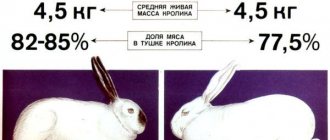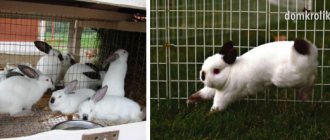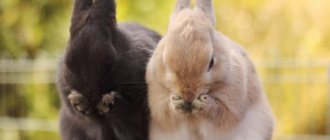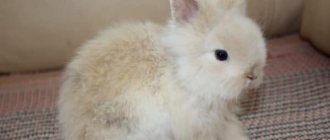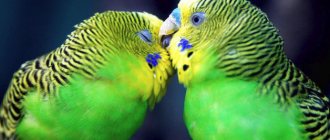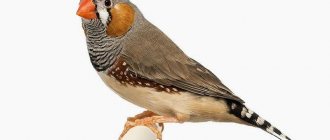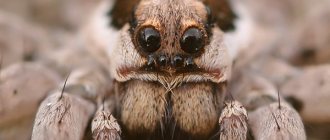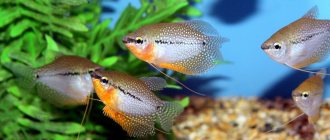General signs of dwarf decorative rabbits
Decorative (dwarf) rabbits are animals weighing in the range of 1.5-2.5 kg, differing in the shape of the head and body, the length of the ears and the thickness of the coat.
Regardless of the breed, miniature animals vary in hair length.
| Type of rabbits | Hair length in cm |
| Shorthair | 1,50 – 2,0 |
| Normal hair | 2,50 – 4,0 |
| Downy (long-haired) | Over 5.0 |
Dwarf rabbits vary in fur length and ear shape
The coat of dwarf rabbits is soft and silky. The body of representatives of this class of rodents is characteristic of all rabbits - rounded, shortened in length. The head looks quite massive, its ratio with the length of the body is 1:2, the neck is practically absent. The ears of miniature rodents can be very short - up to 5-6 cm, or hang below the level of the lower jaw and reach a length of 20 cm.
Breeders are developing varieties of mini-rabbits of various colors
The purpose of dwarf rabbits is different from domestic rodents for meat or fur-and-down production. Their goal is to please their owners with their appearance, affectionate nature and playfulness. The majority of dwarf rabbit breeds are bred for keeping in a home or apartment.
Breed selection
Owners of long-eared animals must decide on the task that they set for themselves: either this is breeding rabbits for meat, or keeping them as a pet for the family. You also need to choose a breed. The White Giant and Soviet Chinchilla breeds produce a lot of good meat and excellent fur pelts. Breeding these varieties of pets brings good profits. It is possible to organize an entire enterprise and it is not so difficult to do, the main thing is to approach this issue responsibly. Decorative breeds include the dwarf fox and the squirrel breed. Their fur is very fluffy.
Breed selection
Depending on the breed and purpose of keeping, you need to decide where the fluffies will live. Regardless of where they are kept, rabbits must have an individual place of residence: at least a small space where they can rest from annoying children or relatives. In its house, the rabbit feels free and safe. The psychological state of rabbits is an important aspect.
Why is the dwarf rabbit offended?
For any reason! I will list just a few reasons for resentment (but in fact there are many more):
* you took the rabbit for vaccination
* you put a harness on your pet and forced him to walk around in it (oh, horror!)
* you scolded a dwarf rabbit for some offense
* you trimmed the baby’s claws, washed him or, God forbid, installed a thermometer (you know where this thermometer is inserted)
* you brought another rabbit! (show this article to those who think that a dwarf rabbit needs a mate)
* you went on vacation and left the rabbit with someone else
So, what do you think of this introductory list?
It turns out that a dwarf rabbit can get offended for absolutely any reason! This does not mean that every pet will be offended by everything. Due to the characteristics and individuality of his character, he will choose what affects him. But in any case, you will experience unpleasant sensations.
Let's sum it up
As our article showed, caring for rabbits is a pleasure. Unpretentious creatures do not require constant attention or exotic food. Even a child who shows the proper degree of responsibility can handle their contents.
Rabbits are great for keeping indoors
Features of keeping rabbits in an apartment
The apartment must be carefully prepared for the arrival of a new resident: remove all unnecessary items from the floor, because rabbits are charming rodents and will want to taste everything they can get their hands on.
Particular attention must be paid to low-lying wires: they will have to be removed completely or hidden in cable channels. The rabbit will most likely also pay attention to wallpaper, shoes and other household items.
Rabbit cage
A place to keep a rabbit should be selected in accordance with your own preferences and capabilities. This could be a cage, house or enclosure. A cage-free option is also possible, because rabbits are very active and mobile animals.
- The cage for keeping rabbits must be selected especially carefully. It is unacceptable to use a plastic cage to keep rabbits.
- Its size should be such that the rabbit can freely stand on its hind legs and not rest against the ceiling.
- A rabbit is a burrowing animal, so it is advisable to darken the part of the cage in which the animal will rest.
- This will ensure a restful sleep and also serve as a place to hide if the rabbit needs privacy.
- A separate part of the cage should be set up as a place for eating. A feeding trough, hay barn and drinking bowl are conveniently located here. The shape of the cell is not particularly important.
- Rabbits do not like drafts, this must be taken into account when choosing a place for it.
Feeder
Particular attention must be paid to the choice of feeder. You should not buy plastic utensils, they will become unusable very quickly. It is better to give preference to a heavy ceramic feeder. This option will avoid tipping over and the food will not end up under the rabbit’s feet. The feeder and drinker can also be hung from the bars of the cage or enclosure.
Cleaning the cage
The cage requires daily attention.
It’s not difficult and won’t take much time, you just need to:
- Replace old food and hay.
- Wash the drinking bowl and fill it with clean water.
- Replace bedding or litter.
At least once a week it is necessary to carry out general cleaning in the cage: more thoroughly wash and disinfect the dishes and the room. For disinfection, you should not use solutions that contain strong chemicals; they can easily get into the rabbit’s stomach or burn its mouth.
Feeding a decorative rabbit
All food necessary for the excellent well-being of a decorative rabbit can be divided into several categories:
- concentrated - cereals, legumes, bran, mixed feed;
- coarse - twig food and hay;
- animal feed – milk, various dairy products, fish oil;
- juicy - carrots, cabbage, green salad, cucumbers;
- mineral - bone meal, salt, chalk.
It is not recommended to feed rabbits with exotic vegetables and fruits (tangerines, bananas, etc.), green potatoes, beets, and dill. Young peas and beans can cause bloating. Yeast bread, cheese, seeds and various sweets should also not be given to rabbits.
Feeding standards for each rabbit are individual. Every day, observing how much the rabbit eats, whether there is food left in the feeder or there is nothing in it for the next feeding, it is necessary to increase or decrease the portion for the pet.
Rabbit fur care
A decorative rabbit must be combed twice a week. For this, a special brush or furminator is usually used. During the molting period, the down of rabbits must be monitored especially carefully. The combing procedure should bring pleasure not only to the pet, but also to its owner.
To avoid tangles and tangles in long-haired animals, you can use various hair care products and sprays. After such procedures, the fur of a decorative rabbit becomes beautiful, smooth and shiny.
Nail care
Unfortunately, living in an apartment is unnatural for a rabbit, so from time to time it becomes necessary to cut your pet’s nails.
Of course, in this situation it is preferable to trust a specialist and take your rabbit to the veterinarian. But you can learn to perform these procedures at home.
Caring for rabbits outdoors
If the purpose of buying rabbits is different - to obtain meat and skins, then the care for them will differ from that provided to domestic animals.
Keeping rabbits outdoors requires the construction of cages, sheds or enclosures, and different categories of animals are kept separately. It will be necessary to arrange housing for:
- animal mating;
- keeping females with cubs;
- young animals;
- manufacturers.
In regions where winters are quite severe, you need to think about how to keep rabbits in your dacha during the cold season. You may have to build a shed or insulate the cages. Particular attention is paid to the arrangement of housing for rabbits with rabbits. They are equipped with a warm queen cell, otherwise the babies will freeze and die.
Many farmers prefer free-range keeping of rabbits. To do this, animals are equipped with enclosures or pits 2 meters deep are used, where the animals live in conditions close to natural. They move a lot, which has a beneficial effect on the immune system.
Free keeping of rabbits
True, this breeding method also has a number of disadvantages, for example:
- fights often occur in pits and enclosures, so animal skins deteriorate and their price decreases;
- infections spread quickly;
- animal meat becomes tougher.
Attention! With any method of keeping rabbits, it is important to avoid overcrowding. Each individual is allocated a minimum of 0.7 m2 of free space.
Keeping rabbits outside is not suitable for residents of northern regions. Where in winter the air temperature drops to -25 degrees, it is advisable to move the cages indoors.
Caring for a cat after castration in the first hours
After castration, a cat needs special care. Most veterinary clinics provide post-operative hospital services. In a special box with optimal climatic conditions, the operated pet is observed until it completely recovers from anesthesia. Once convinced that the cat’s condition is satisfactory, it is handed over to its owners.
Care in the first hours after castration comes down to monitoring your pets
If such a service is not available in the clinic or castration is performed at home, it is important to follow the following care recommendations:
To transport a cat after castration, it is recommended to use a loose carrier with a folding top and an absorbent diaper on the bottom. It is forbidden to transport an operated pet in your arms or in a car seat, as when waking up from anesthesia, it can harm itself or its owner. During transportation and further postoperative stay, the cat is placed on its side; It is recommended to lay an anesthetized, operated cat on the floor, since when it comes to its senses, it may fall off the table/sofa/bed. A common symptom of anesthesia sleep is uncontrollable urination. Using an absorbent diaper placed on the floor under the pet will make it much easier to eliminate such a nuisance; During anesthetized sleep, body temperature drops by 1-1.5°, so to prevent hypothermia, the operated pet is placed next to a heating radiator. It is strictly forbidden to place animals near electrical appliances with an open heating element. Instead of a battery, you can use a heating pad or a plastic bottle with hot, but not boiling water, which is placed next to the cat under a bedding or blanket
It is important that the heat does not come into contact with the cat's perineum, as this will cause bleeding. During the warm season, no additional warming procedure is required; for a more comfortable awakening from anesthesia sleep, it is recommended to close the curtains on the windows, since bright sunlight causes irritation of the optic nerve; Anesthesia sleep lasts from 15 to 120 minutes. depending on the method of administration and dose of the drug
During this time, it is necessary to monitor the cat so that it does not bury its nose in anything and suffocate. In addition, cats in this condition do not blink, which can cause the cornea to dry out. It is recommended to drip sterile saline solution, contact lens liquid, or eye drops without antibiotics into the eyes several times;
A protective collar will prevent your pet from licking the wound, further irritating it.
- Often waking up after anesthesia causes aggression in the pet. Therefore, it is recommended to provide the cat with complete rest for 24 hours, limiting access to him by other animals or children. It is forbidden to forcefully wake up your pet. Depending on the individual characteristics, after waking up, the cat may experience an unsteady gait, vomiting, involuntary urination, and a lethargic and drowsy state. This condition can last up to 8 hours, which is normal and should not cause concern;
- the wound on the scrotum after castration is not sutured, so it is recommended to minimize the amount of filler in the tray or replace it with absorbent paper. This will prevent the ingress of small filler particles and subsequent complications;
- A few hours after surgery, there may be slight bleeding from the incision, which is normal and safe for the cat. You can lightly dry the wound with a gauze cloth. In case of significant bleeding of more than 1 ml, you should urgently contact the doctor who performed the operation;
- Medicines prescribed by a veterinarian will help relieve pain. You can tell that a cat needs pain medication by dilated pupils, meowing, pursed paws, and aggression when attempting contact;
- You can prevent the possibility of damage to the healing incision by the cat’s rough tongue during hygiene by wearing a protective collar around the neck for several days. Such a product will limit the cat’s access to the wound without affecting food intake in any way.
Note! Veterinarians recommend castration in the fall or winter months, as during this period the likelihood of infection of the incision during rehabilitation is lower. In the summer, as a preventive measure for infection, the doctor prescribes a 5-day course of antibiotic treatment.
Provide a comfortable place to stay
This section will talk not only about the cage, but also about the location of the rabbit house. Storerooms and closets are not suitable for long-eared life: there is too little light and air. Fluffies are very sensitive to mustiness and dust in the air. Lack of oxygen in the location of the rabbit's home will sooner or later lead to the death of the furry friend.
When choosing the part of your house where the long-eared one will live, avoid cool corners with drafts. Constantly resisting cold air currents, the rabbit will weaken and catch a severe cold. However, you should not place the house near the radiator, since rabbits do not like heat.
It is better to place the rabbit cage in a warm and dry corner of the apartment.
Home security should also be high. All sharp objects that threaten the integrity of the rabbit’s coat and skin should be removed from the premises. Pick up wires from the floor that the animal would like to chew on, and plug up any cracks large enough to fit through.
Prices for cages for rabbits
Rabbit cage
Arrangement of the cage
Some progressive owners allow their pet to be free all the time and travel around the apartment without restrictions. Intelligent animals gradually learn to avoid danger and also feel great. However, in order to regain strength, the pet needs a safe shelter, which is usually a cage.
When buying a cage for a rabbit, pay attention to its size. It must be spacious, at least 60 centimeters long, so that the pet can move freely inside. Purchase the item with the pallet right away. A simple slatted bottom can damage your pet's paws.
Rational use of the internal space of the cell
Cover the floor of the house with filler. It can be soft cat litter, straw or sawdust. Install a toilet in the cage or behind the fence, which is an ordinary cat litter box.
Is it possible to grab it by the withers?
If you look at the photo below, you will see that it is also not recommended to take an animal by a fold of skin on the neck or back. This is not as dangerous as in the case of the ears, but there are other, safer ways.
The fact that this method is more comfortable for the animal is evidenced by the fact that, as a rule, in this situation it does not break out or scratch. Most often, the crawl simply hangs down, while its neck and head are pulled back somewhat.If you use this method of lifting, then you must support the crawl’s body in the sacrum area with your second hand.
By the way, it is by the withers that the rabbits are carried by their parents. Some rabbit breeders advise holding animals with both hands at the same time: one in the neck area, the other in the back area. This way it will be in a horizontal position, and the body weight will be evenly distributed.
How much do rabbits cost?
Different breeds cost differently, the price fluctuates depending on the region and place of residence. Also, the price depends on where and from whom the pet is ordered. Many farmers order animals from Europe, where prices must be converted into euros. If the purchase occurs from breeders from Russia, the price must be converted into rubles. For breeders, the price will be higher, because high-quality breeding should pay off.
A self-respecting breeder provides the buyer with all the necessary information about the pet’s parents, possible predispositions to diseases and character traits.
If you wish, you can ask to show a photo or video of your pet, find out how and where it was kept, what it was fed, what vaccinations it was given. The price for the simplest breed can start from 1-2 thousand rubles. for one individual with documents and vaccinations.
If you buy a rabbit by hand or at a poultry market, the seller will not always have documents for the animal. Besides, it may turn out to be sick. The price for such pets starts from 500 rubles. for one individual. As a rule, a female and a young rabbit will cost more, because they have the ability to reproduce.
Difference from sterilization
Castration of rabbits is an operation as a result of which they are deprived of the opportunity to have offspring. Spaying rabbits is sometimes called neutering, but there is a significant difference between the two. Since sterilization does not involve resection of any organs, the ability to reproduce disappears, but the natural desire to mate remains.
Sterilization of rabbits involves bandaging. In this case, the reproductive organs are ligated - in females the fallopian tubes, and in males the seminal ducts. The behavior of animals during certain periods remains aggressive and unpleasant.
Unlike sterilization, castration of rabbits immediately solves all problems that have arisen. The result of castration of rabbits is the absence of pregnancy. Their behavior also changes - they stop falling into a state of hunting, that is, the natural desire to mate disappears. Even during the mating season, their behavior continues to remain calm.
The essence of castration of rabbits is to cut off the ovaries in females and the testicles in males. You can have your rabbit castrated by professionals or by yourself.
Methods of content
All methods of keeping domestic rabbits have pros and cons. Based on this analysis, you can independently choose the method that is best suited for your pets. The most popular content is in sheds. If you have a drawing, you can make them yourself, and it is not as expensive as a separate room. Pets feel fine in sheds.
Cell
This is the classic way. This is how rabbits are kept at home in our time, this is how they were kept many centuries ago. It is best for beginning rabbit breeders to use this method.
Cage maintenance is simple, the cage can be easily placed in an apartment or private house. The animal can be let out for a walk around the house. This method will not work when keeping several individuals. When breeding and keeping more than 5-10 pets, you need to choose a different method of raising animals.
Types of cells
There are 2 types of cells:
- stationary
- portable
Stationary cells are always in one place. They cannot be moved, depending on the change of weather, the change of seasons. As a rule, cages are installed in a barn or in regions with a warm climate outside, making a canopy from the rain.
Portable cages are universal. In the summer they stand outside, in the winter they move into a warm room. Portable cages are more functional and convenient to use, although each farmer decides at his own discretion which cage to choose.
A female rabbit with offspring needs wider, more capacious cages, while males and older rabbits need smaller cages. They can be purchased in specialized stores or built independently, especially since there are a large number of training videos on this topic. Homemade and store-bought cages are made of durable plastic or wooden slats with a metal mesh. The size of the cells depends on the breed. The larger the adult male, the larger the home should be. The best option for representatives of not the largest breed is 1 m in length, and the height and depth are 50 cm.
Positive aspects of cage keeping
- Individual approach to each individual. Care for decorative rabbits at home must be of high quality, otherwise the animals will die. If the female rabbit is in a cage with cubs, fenced off from other mothers, it is possible to monitor how much food she has eaten, what her stool is like, and how the babies from this particular female are developing. The same applies to males and young animals. It is impossible to carry out such control in a common enclosure.
Keeping rabbits in cages
- Optimization of feed consumption. The amount of feed is reduced, and caring for any rabbit at home is simplified. This way it is possible to see whether an individual individual has food in the feeder or no longer. Add food at the right time - the rabbit is always full. When eared animals live en masse in one room, the shyer individuals often go undernourished, as a result the owner tries to provide more food so that all the animals are well-fed. Hence the increase in food consumption for pets.
- The risk of mass disease infection is reduced. Everything here is like people's. During a flu epidemic, schools and kindergartens are closed so that the disease does not spread, but here all the rabbits sit in their own separate houses in advance, so the likelihood of infection is reduced.
Disadvantages of cellular housing
- Large costs for equipping rabbit habitats. Construction materials are expensive. For a large farm you also need a lot of cells. Accordingly, in order to improve a rabbit farm, you need to spend an impressive amount. To reduce costs, it is possible to build the cells yourself. It will be cheaper than buying equipment (cages) in stores.
- Increased rabbit maintenance work. Remove an enclosure or 50 cages, which is easier? The answer is obvious. Distributing food individually also requires more time and effort.
A domestic decorative rabbit should also have a cage. Not even a cage, but a house. The choice of housing for such pets is extensive in pet stores. The cage or house should be 5-8 times the size of the rabbit. The pet must take a daily walk. It would be better if there was a garden near the house. Active games and running are the key to your pet’s health.
Free content
Free housing on farms is used much more often than cage housing. This method allows rabbits to live in almost natural conditions. Animals that are kept freely develop and reproduce better.
Free keeping involves living rabbits outdoors in any weather, winter and summer. During periods of extreme cold, it is necessary to insulate the premises for resting and heating pets. Free maintenance is more suitable for small farms.
Free keeping of rabbits
On an industrial scale, keeping thousands of heads of rabbits freely is very problematic: large areas are needed. Free-range farming is practiced by small farmers who organize rabbit farms in the courtyard of a village house.
When kept freely, it is not always possible to keep an eye on the animals. There is also a risk of accidental relationships between rabbits.
Free keeping of pets is not suitable if the purpose of raising them is to obtain valuable fur. In such conditions, the rabbit's fur can become dirty and damaged.
Contents in the pit
This is the most favorite type of free-range breeding among experienced farmers. Pit keeping at home for beginners is a simple and low-cost method. It is enough to dig a hole for a small number of rabbit heads, and they will do the rest themselves.
The female rabbits will dig a den for the winter and make separate rooms for giving birth. The owner will only have to prepare the awning from rain, snow and sun, put up feeders and water containers. Is it possible to keep all rabbits in one pit? It is possible, but the hole must be deep and wide. For several individuals, the size of the hole is a couple of meters.
The pit area can be made square or rectangular. This factor does not matter. The pit maintains the temperature necessary for the rabbits to live all year round. When choosing a place to dig a hole, you must take into account that groundwater can flood it. It is advisable to choose a higher place. You should not place the pit near sewer pipes or drainage systems: rabbits will finish building their home on their own and the pipes will interfere with them. Keeping in a pit is only suitable for meat breeds of rabbits.
Keeping rabbits in a pit
If your plans are to get beautiful fur, it is better to choose another option. When kept in a pit, the animals' fur will be tangled, and the skin will be damaged when fighting for a female or territory. Breeds of rabbits such as Butterfly, Soviet Chinchilla, etc., give a good income in pits. Pit housing preserves an independent lifestyle for pets. They only expect food, drink, and cleaning from their owner.
The owner will not be able to control the long-eared animals.
Keeping on pasture
From a material point of view, this is beneficial if you take into account all the features and approach this content correctly. Both flocks of young animals and adults can be raised on grazing. Animals also expend less energy. When grazing, rabbits have stronger and more stable immunity to common diseases. Rabbits live in a separate mini-territory with natural food and there are practically no clashes between them.
Keeping on pasture
In the summer, while the green grass is growing, the farmer will only have to supply them with drink. Drinkers are installed within the pasture. It is imperative to install fences, make a canopy, and arrange places for rabbits and young animals. A canopy and fence will protect them from attacks by large birds and wild animals. It is advisable to have a protector in the form of a dog not far from the grazing area.
The positive aspects of free content
Free-run rabbits:
- spend a lot of time outdoors;
- move a lot;
- eat natural food;
- get sick less;
- reproduce faster;
- gain weight well;
- have good meat;
- become more resilient;
- less aggressive.
Another benefit is that the cost and effort of feeding and cleaning are reduced.
Cons of free content
Among the negative aspects are noted:
- a high percentage of mortality when infected with diseases;
- inability to fully control the entire herd;
- degeneration of rabbits after several years of this type of maintenance, reduction in size from generation to generation.
Keeping in enclosures
It is better to keep meat rabbits in enclosures, as shown by many years of experience of rabbit breeders. But this type of maintenance is only suitable for seasonal work. For example, if you decide to raise rabbits for meat in a village or country house in the summer, this option is ideal. It is necessary to fence off a small area for animals at the rate of 5 square meters. m for a female rabbit with small and newborn rabbits, for the rest - 1 sq. m. m for 1 head. In the enclosure, rabbits feel calm and free. The main thing is that it is not cramped. Crowding contributes to fights for territory and the spread of livestock diseases.
What should an aviary look like?
It is imperative to cover the enclosure with a canopy or awning: this will protect the animals from heat and rain. It is especially important to make a shelter for a rabbit with babies. You can also install a large cage and several small ones so that the rabbits can create their own personal space. A favorite pastime of rabbits is digging holes of various depths and sizes. It is necessary to carefully strengthen the walls of the enclosure.
It is necessary to dig the fence to a depth of 1.5 m, at least 0.8 m, otherwise the rabbits will quickly get out of the artificial house and breed in the wild. Feeders and drinking bowls should be placed along the fence. They should be long, not very deep gutters. You also need to hang a protective canopy for the feeders. Street birds will easily fly to pets for dinner, increasing the consumption of purchased food. You must carefully monitor the cleanliness of drinking bowls and feeders.
Advantages of keeping in an aviary
- Versatility of the structure. Birds and other animals can be kept in enclosures, but not at the same time. Chickens suffer from various diseases that are fatal to rabbits. Birds often peck and injure small rabbits. Indoor rabbits may not get along with down rabbits, therefore, to prevent breeds bred for their fur from getting hurt and spoiling their fur, it is better to keep them separately. If you keep a breed of young animals from birth in special premises, then you need to insulate such houses in winter. It is impossible for offspring or young animals to develop frostbite at birth.
- Portable enclosures are available for sale. They are perfect for keeping decorative pets. This dwelling is much more spacious than a cage or house, although in a city apartment the enclosure occupies a larger area, which not every rabbit owner can afford. The entire herd must be placed in the enclosure at once. These must be individuals of the same size and age. If after even a short time a newcomer, especially a young rabbit, is placed with them, he risks getting into a fight. Rabbits do not tolerate strangers and never accept newcomers into the family.
Accommodation features: rabbit house
If you decide to get rabbits and create a mini-farm in the village, then at the first stage you need to take care of their place of residence. A ready-made room for a rabbitry is created or used. The animals will be housed more compactly in 2-tier cages. Keeping rabbits indoors is more convenient and rational. Drafts and dampness, prolonged exposure to the sun should be avoided, but ventilation should be provided.
Outdoor home cage option
For a pet, the cage is placed away from heating appliances. If you raise a rabbit in a hot room, the rabbit will experience constant thirst and its health will worsen. It is not recommended to keep him in a cage all the time. In order for the indoor pet to feel good, it is allowed to run around the apartment.
Longer stay for pets - their cage
Keeping an animal’s “house” clean is an important condition for its health. Dirt and urine cause diseases of the respiratory system and eyes, so the tray is cleaned three times a week
Once a week, wash thoroughly using disinfectants.
Portable cage option
Feeders, drinking bowls, and hay mangers should be placed in the cage. They need to be well secured so that the animals cannot spill water or contaminate the food. They need to be washed as often as possible.
Animals love to eat indoor flowers. It is necessary to remove poisonous plants from the apartment, install the rest on cabinets or hang them in flower pots.
Is it possible to keep rodents together with chickens? Their cohabitation is possible only if there are no other options. Although they are completely different species, they have common diseases. In addition, the “eared” ones feel uncomfortable in the company of noisy and hectic hens. Therefore, keeping chickens and rabbits together is not recommended.
Important Features
Before you get a floppy-eared friend, you need to understand some important behavioral and other characteristics of rabbits. Read the information listed in this section carefully and explain it to your child. The more attentive the owners are to the ward, the longer he will live, pleasing the owners.
Stress is the rabbit's main enemy
Eared pets boast a highly developed nervous system. This means that the rabbit's reaction to any inconvenience is very painful. Constant incidents in an animal's life will sooner or later lead to illness and death.
Your pet needs to be protected from stress
Rabbits are very afraid of:
- too bright light;
- unexpected outbreaks;
- sharp sounds;
- changes in daily routine.
Pay close attention to your pet's needs and try not to disturb him while eating, using the litter box, bathing or sleeping. Believe me, untimely affection of the owner will alert the big-eared one, and not make him happy.
Rules for treating rabbits at home
To cure a pet, owners use both chemicals and traditional medicine.
Medications
To treat purulent otitis media, antibiotics are used. Good results are observed when using Chloramphenicol and Bicillin. Ciprofloxacin is also used to treat otitis of the inner ear. The course of treatment usually lasts about one and a half months.
To rid the animal of ear mites, local treatment in the form of ointments is prescribed. First of all, the skin is cleaned of crusts and scabs, lubricating the damaged areas with Psoroptol spray. In case of severe spread of the disease, the veterinarian may prescribe subcutaneous injections of the drug “Baymek” and “Decta” drops.
It is also effective to use aerosols in the treatment of psoroptosis. A solution containing chlorophos, neocidol, sulfidophose and cyodrine is sprayed from a distance of 15-20 cm for several seconds. In this case, it is necessary that the medicine gets on the inside of the ear, and the eyes, nose and mouth of the animal are closed.
Folk remedies
Such treatment methods are effective in the initial stages of diseases. If your pets are affected by ticks, you can use camphor oil to irrigate the affected ear areas. The substance is drawn into a syringe without a needle and the skin is carefully treated. You can also use turpentine.
Expert opinion
Zarechny Maxim Valerievich
Agronomist with 12 years of experience. Our best country expert.
Ask a Question
Important! To treat leather, turpentine is diluted with vegetable oil (castor, olive, sunflower) in a ratio of 1:2. It is folk remedies that allow you to gently remove crusts and scabs from the surface of the skin.
A common recipe: glycerin is diluted with iodine in a ratio of 4:1 and the crusts are lubricated once a day (2-3 days). Thanks to iodine, sores are also disinfected. You can also use a mixture of glycerin, kerosene and vegetable oil, taken in equal parts
It is folk remedies that allow you to gently remove crusts and scabs from the surface of the skin. A common recipe: glycerin is diluted with iodine in a ratio of 4:1 and the crusts are lubricated once a day (2-3 days). Thanks to iodine, sores are also disinfected. You can also use a mixture of glycerin, kerosene and vegetable oil, taken in equal parts.
How to properly trim the claws of decorative rabbits at homeRead
Proper feeding
A proper diet allows an animal to quickly gain weight, which is especially important for meat production.
Summer diet
In the summer, concentrates become the basis of rabbit nutrition - 30-40% of the total feed per day. 30% - green food, 20% - succulent, 10% - roughage.
Rules for feeding Eared Ears:
- Give concentrates first, and then greens.
- From the period of weaning until old age, rabbits are fed 3 times a day.
- Pregnant female rabbits and females with babies up to 2.5 months are offered food 4 times a day.
- Daily feed requirements: good concentrate feed – 55 g, grass – 600 g.
- At 6-7 o'clock in the morning, give ½ of the daily norm of concentrate, and 1/3 of the norm of grass. At lunch 15 o'clock another 1/3 of greens. In the evening at 19:00, offer the rabbits the rest of the concentrates, 1/3 of the greens and some roughage.
Winter nutrition
Not only the quality of meat, but also the condition of the animal’s skin depends on the diet in winter.
Winter feeding recommendations:
- If the air temperature outside reaches -15 °C degrees, then you should remove frozen food debris in a timely manner, since animals cannot eat them.
- You can add hay, twigs, silage, heated mash, and pine needles to your diet.
- The average daily doses for one animal are: feed – 80 g, hay – 400 g + additives.
- Watering of the animals is carried out in the morning and evening. For sub-zero temperatures, use warm water or purchase drinking bowls with a heating function.
Vitamins and mineral supplements
Vitamin complexes are used for feeding in late winter, when feed reserves are depleted. Animals need vitamins A and D. To do this, they are added to the diet in the form of concentrate or fish oil.
The amount of fish oil per head depends on the activity and age of the animal:
- baby rabbit – 0.3-0.5 g;
- adult rabbit – 1 g;
- pregnant and lactating rabbits – 3 g.
The lack of vitamin E is compensated by good meadow hay, sprouted grain, and silage. You can add a little bone meal, chalk or bone ash to the food.
It is mandatory to feed your pets salt - 1-1.5 g per day.
Feed for slaughter
Feeding rabbits for breeding requires a balance between carbohydrates and proteins.
Tips for accelerating weight gain:
- Feeding with silage. This is a valuable source of vitamins and minerals, especially in the winter and spring.
- The daily dose of feed is 80 g, and hay is 400 g.
- For intensive growth of young individuals, branch feed is used: willow, willow, and aspen twigs.
- Root vegetables and melons: potatoes, pumpkin or zucchini. They are boiled and mixed with feed granules.
- In veterinary pharmacies you can buy vitamins and minerals and feed young animals according to the instructions to accelerate growth.
Annual feed requirement
At each life stage, rabbits' food needs are different.
Annual requirement (average):
- Breeding rabbit or rabbit in the period between matings: feed - 4.46 kg, silage - 3.2 kg, hay - 1.2 kg, greens - 4.5 kg.
- During the mating period: concentrates - 4.2 kg, hay - 1.5 kg, silage - 3.8 kg, greens - 5.6 kg.
- For a pregnant rabbit: concentrate – 16.8, meadow hay – 6 kg, root vegetables – 15.6 kg, green grass – 23 kg.
- Nursing mother: feed - 62.4 kg, silage -57 kg, green grass - 83.4 kg, hay - 21.1 kg.
- For a young rabbit: concentrated granules - 10.1 kg, silage - 40 kg, greens - 12 kg, hay - 3.1 kg.
What not to feed
Young animals under 3 months should not be given complementary foods in the form of grass and succulent feed. The first time, give new types of food a little at a time and monitor the condition of the livestock and the type of feces.
Rabbits should not be fed:
- wet herbs (given dried or dried);
- milkweed, datura, celandine, tansy, wormwood, aloe, arisema, beans, cornflowers;
- seeds and mushrooms;
- any bakery products;
- sugar;
- figs;
- milk;
- avocado;
- nuts and peanuts;
- corn and pea husks.
How to care for decorative rabbits - choosing a cage
Selecting a location
You should not place a cage with a rabbit next to the air conditioner or near the radiator. The optimal temperature for rabbits to live is +20° Celsius. Animals experience stress from loud noise, bright sunlight and being around other pets.
Does your rabbit live in a cool room? Poll Options are limited because JavaScript is disabled in your browser.
Arrangement
Rabbit feeders
There are several rules for choosing a rabbit feeder:
The container needs to be as easy to use as possible: so that it can be quickly removed and reattached and cleaned. Pay attention to the capacity of the feeder. Keep in mind that the feed mixture will be poured in for a long time, so the container must be large enough. Make sure there are no burrs, sharp cutting edges, or dangerous corners on the feeders.
Drinking bowls
The choice of devices for watering rabbits should be based on several basic criteria:
the drinking bowl must stand steadily on the surface so as not to overturn and contaminate the surface of the rabbitry; there should always be plenty of water in the drinker, therefore, it is advisable that the device is replenished automatically; it is important to maintain the purity of the water in the device, therefore, it is best to use a closed type of drinker; The material from which drinkers are made must be non-toxic.
Keeping the cage clean
Cleanliness is the key to health, and since rabbits are quite clean animals, it is recommended to disinfect them twice a year.
Rabbits love dandelions and clover
How to litter train a pet rabbit?
Keeping rabbits outdoors does not involve training the animals to use a tray. Pets should be able to relieve themselves without polluting the apartment. It is recommended to place the tray in the far corner of the cage, and install a hay manger next to it. This way, the animal will quickly learn to go to the toilet in the right place, because rabbits often defecate while eating.
When the animal gets used to using the litter box in the cage, you can get another toilet and place it in the apartment. When the pet goes there, he needs to be praised and rewarded with treats.
Rabbit nutrition
The main diet of rodents consists of the following products:
- hay;
- compound feed;
- twig food;
- green juicy food;
- mineral stones;
- pure water.
Combined mixtures already contain all the nutritional components necessary for individuals. So, small rabbits are given a tablespoon of feed three times a day. Adult pets are fed twice a day, but they already need one and a half to two tablespoons of food at a time.
Grass pellets for rabbits
It is not recommended to feed rabbits that rarely leave their cages with large amounts of feed - this provokes obesity in individuals
It is important to ensure that there is always a lot of hay in the rabbits’ cage, because its consumption has the best effect on the digestion of rodents
Branch food is not only a source of valuable microelements, but also allows rabbits to grind their teeth. It is allowed to give pets branches of the following trees:
- pears;
- apple trees;
- birch;
- linden;
- aspen;
- maple;
- poplars;
- oak
In the summer, it is recommended to feed your pets with green branches with leaves, and in winter with coniferous branches. Any branches must first be thoroughly washed to remove dirt (if necessary, soak in boiling water) and then dried.
Branch food is good for pets
As a source of minerals, rabbits are fed chalk and given salt and vitamin stones. You can purchase such additives at any pet store, but if the number of rabbits is large, it will be more profitable to order the products in bulk from a farm warehouse.
Pets should always have fresh water in their drinking bowls; it should be changed before each feeding.
In the warm season, animals are allowed to be fed with herbs:
- mouse peas;
- clover;
- alfalfa;
- yarrow;
- chamomile;
- nettle.
It is not recommended to feed rodents parsley or dill - these herbs contain many essential oils that do not have the best effect on the digestion of rabbits.
Rabbits are often fed dried grass
Another traditional food for decorative rabbits are vegetables: carrots, beets, cucumbers, melons, zucchini, potatoes (the latter is best given boiled).
It is better to cut vegetables into pieces
It is worth noting that a sudden change in food often causes digestive upset in rodents, so any new products must be introduced gradually so that the rabbit’s body gets used to it.
It is worth highlighting some food that is dangerous for rabbits, and in particular grass. Therefore, when cutting hay, you need to be careful to prevent the following herbs from getting into the general pile:
- wormwood;
- milkweed;
- celandine;
- Datura.
Recipe for treats for rabbits: step-by-step instructions
Step one: we need to prepare all the ingredients for the treat. You will need 50 grams of combined food, 2 tablespoons of oatmeal, water and grated zucchini (you can take any fruit or vegetable).
You need to grate the vegetable using a medium grater.
Step two: now you should grind the food and rolled oats in a coffee grinder.
Grind until smooth
Step three: then all this must be poured into a common bowl and filled with warm water.
You must also add zucchini to the resulting mixture.
Step four: from this mass you need to knead a kind of dough, and then divide it and form figures.
The result will be cookies that are readily consumed by decorative rabbits and any other rodents.
This delicacy should be distributed in portions among all individuals, and it is better to remove the pieces that are not eaten during the day from the cage, because they can turn sour.
Plant food for rabbits
Green herbs, both meadow and sown, as well as hay from them. Young winter crops, not overgrown oats with vetch, millet, clover, seradella with jper-gel, sainfoin, alfalfa , chicory (leaves and roots), dill , caraway seeds. Among the weeds the rabbit likes: dandelion, wormwood, sage, and wild mountain ash.
Harmful herbs for rabbits
: poppy, hemlock, nightshade, datura, foxglove,
spurge , lettuce, henbane, wolfberry, bulbous plants, leaves and fruits of stone fruit trees (cherry, plum, etc.).
Green herbs are given to the rabbit only fresh, not covered with dew and not withered, i.e. not when they start to wander. When switching from dry food (hay and grain) to green food, be careful to avoid diarrhea and bloating, especially when switching to clover, alfalfa, and sainfoin. Woody vegetation can sometimes produce branches with leaves of aspen, birch, poplar, acacia, ash and maple.
Basic care requirements
A rabbit is a mobile animal that needs activity. For walks, he is wearing a harness (collar with leash). In order not to scare the animal, the harness must be put on carefully and slowly. The harness is not tightened, but fastened, otherwise the rabbit may strangle itself out of fear.
Before purchasing a pet, carefully study the question of how to properly care for rabbits. There are many important care techniques, without which the animal will feel uncomfortable.
Nail trimming
When kept in grazing conditions, the claws grind down on their own, but in apartment conditions this is impossible. The cutting technique is simple; the claws can be cut with clippers. The procedure is carried out regularly: the claws are cut once a month. Trimmed claws are neatly filed
Trim them carefully as they contain capillaries
Vaccination
Furry pets are susceptible to various diseases, so vaccination is very important. Vaccines are administered at one and a half months of life, when the baby rabbit weighs 0.5 kg. It is necessary to vaccinate rabbits during this period.
Fur care
The animal's fur needs daily care (even during molting) so that tangles do not form in the fur. Hair mats quickly, so use a comb or slicker for cats or dogs. Wool often gets into the animal's stomach, clogging the intestines. This is the most dangerous disease that can be prevented by caring for your fur.
Bathing a rabbit
Is it possible to bathe rabbits? A furry pet does not need this procedure when it is at home. Yes, and washing it is not so easy. If the rabbit is very dirty, then bathing is necessary. The process of taming to this procedure is impossible. If the contamination is partial, then wipe the dirty area with a damp cloth.
Grinding down teeth
An animal's teeth grow throughout its life, and caring for a rabbit at home involves regularly grinding them down. Teeth are ground down using:
- Special feed;
- Hard vegetables;
- Branches of fruit trees;
- Special sticks with vitamins and cereals, toys.
Castration
Castrating a rabbit at home involves removing the male reproductive organs. Sterilization is a necessary procedure that helps:
- Increase their growth by 20% without additional costs for feed;
- Keep males in one cage;
- Indoor rabbits stop breeding;
- Increase their lifespan.
Castration of rabbits promotes their calmer behavior: they are not aggressive and do not bite. They are neutered between the ages of 4 months and 2 years.
Puberty
Having bought a rabbit to keep at home, you should think about whether it will have a mate. At the age of 3–4 months, rodents begin puberty. At the same time, pets become restless and even aggressive. Males mark their territory by scattering droppings. The owner will have to make a decision - to resort to castration of the animal or get him a mate.
Reproduction
Sexually mature individuals reproduce quickly. At home, females are ready to mate almost every month. After mating with a male, pregnancy occurs, which lasts 28–32 days. In one litter, from 5 to 12 rabbits are born. It is important to consider in advance whether it is advisable to keep a couple of rabbits at home.
Rabbits mating
Castration
Most pet owners resort to castration or sterilization. This procedure is carried out from the age of four months in a veterinary clinic. After it, rabbits are not able to reproduce, their behavior returns to normal.
Attention! Castration allows you to extend the life of an animal, since its body does not wear out as quickly as that of individuals that bear offspring.
Caring for babies after weaning
The longer baby rabbits are kept with their mother, the better they will develop. As a rule, they can be weaned from a female rabbit within a month. But it is still advisable to wait at least 50 days. Before weaning, the cage should be prepared, and for this purpose it should be disinfected. Rabbits of different sexes are placed in different cages.
Babies have a good appetite at this time. They are first fed crushed barley, and then gradually switched to whole grains. You can give them oats. Small rabbits grow quickly and the straw or grass bin needs to be filled regularly. Babies can also be given branches of fruit trees, but they also need succulent food. Root vegetables like carrots, Jerusalem artichoke, and Daikon radish are ideal for this. In summer, ordinary vegetables from the garden will go well - cucumbers, pumpkin, beets, zucchini. You can offer apples and pears.
In a certain sense, the diet of rabbits is approached in the same way as complementary feeding of babies. That is, you need to introduce a new product carefully, gradually increasing the portion over several days and not combining it with other new products, so that the digestive system has time to prepare.
The development of baby rabbits occurs quite quickly, but you need to keep an eye on it. Healthy rabbits are cheerful and playful, and they should have thick, shiny fur. If an animal looks lethargic, then it needs to be quickly placed in another cage so that it does not have time to infect others.
